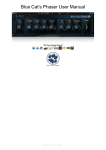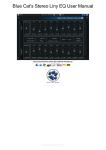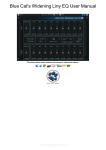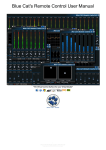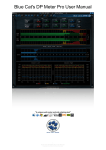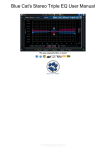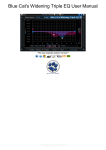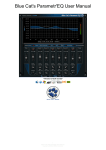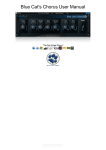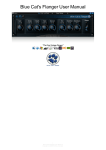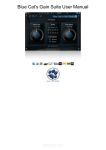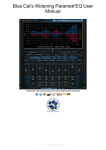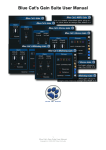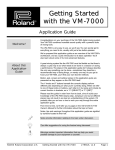Download Blue Cat`s Stereo Phaser User Manual
Transcript
Blue Cat's Stereo Phaser User Manual
"The vintage analog- style stereo phasing effect."
1
Blue Cat's Stereo Phaser User Manual
Copyright (c) 2005-2010 Blue Cat Audio
Table Of Content
Introduction
Description
Main Features
System Requirements
Installation
Using Blue Cat's Stereo Phaser
The User Interface
Operation
Blue Cat Audio Plugins Basics
User Interface Basics
Controls
Keyboard
Mouse
More
Blue Cat's Stereo Phaser Parameters
Plugin Settings
The Global Settings Window
The Preset Settings Window
About Skins
Changing the Skin
Create a Custom Skin
Frequently Asked Questions
More
Extra Skins
Tutorials
Updates
Versions History
Note: An html version of this user manual is available online here.
2
Blue Cat's Stereo Phaser User Manual
Copyright (c) 2005-2010 Blue Cat Audio
Note: An html version of this user manual is available online here.
Introduction
Description
This plug- in is the stereo version of the original analog- style Phaser effect. With this one it's now possible to obtain a stereo
phasing effect with a single parameter that controls it.
From mono to wide stereo phasing, the transition is smooth and continuous: it's fully automatable and easy to control. The effect
has been modeled after the same kind of vintage circuits as the original Phaser plugin which offered a stereo capability.
Like the mono version, this plug- in supports MIDI control and Blue Cat's Skinning Language to give you total control over the
sound.
Main Features
Multi- stage analog- style stereo phaser effect.
Up to 32 phasing stages.
Very simple stereo width control.
No latency.
Blue Cat Audio Standards:
Supported platforms: Mac- AU, Mac- RTAS, Mac- VST, Windows- DX, Windows- RTAS, Windows- VST, Win x64- DX,
Win x64- VST.
Native DSP code for optimal performance.
Skinnable user interface.
Smooth Update: silent (zipper- free) parameters update.
Full automation support (all parameters can be automated, with smooth and continuous update)
No CPU load on idle: when the plugin is fed with silence, the processing smoothly shuts down, to optimize the CPU usage
of your Digital Audio Workstation.
Real time MIDI control with advanced settings (MIDI channel and CC numbers, with complete response curve control) and
MIDI learn.
Smooth Bypass: activate/ deactivate the plugin with absolutely no noise.
Undo/ Redo.
Import/ Export presets in a host independent format.
Any sample rate supported.
System Requirements
PC
Microsoft Windows XP, Vista or Windows 7.
Any DirectX / VST / RTAS compatible host software - 32 or 64 bit.
Mac
An Intel or PowerPC processor.
Mac OS X Leopard (10.5) or Snow Leopard (10.6).
Any VST / Audio Unit (32/64- bit) / RTAS compatible application.
For more information about supported platforms, see our FAQ.
Installation
Blue Cat Audio plugins cannot be run standalone, they require a host application (see the System Requirements chapter for more
information). Depending on which host application you use, you might need to install the plugins in different locations.
Windows
Install
Both DirectX and VST versions provide an install program. Follow the steps of the wizard to install the plugin on your machine.
During the installation you will be asked where you want the plugin(s) to be installed. For the VST version you should install the
plugin inside the VST plugins folder used by your host application(s). The default path set in the installer should work for most
applications, but you should check your host software documentation to know where it looks for VST plugins.
3
Blue Cat's Stereo Phaser User Manual
Copyright (c) 2005-2010 Blue Cat Audio
Some applications will not automatically rescan the new plugins, so you might have to force a refresh of the plugins list.
Upgrade
When a new version of the plugin is released, just launch the new installer: it will update the current installation.
Mac
Install
On Mac the plugins are available as drive images. After download, double click on the file to open it. You can then drag and drop
the plugin file(s) to the shortcut that is provided within the image. It will install the plugin(s) for all users on the machine.
In case you do not have admin rights on your Mac or if you want to install the plugin(s) to another directory, just copy the files to
the appropriate location. If required, more information is available in the README.txt file that is included in the package.
Upgrade
When a new version of the plugin is released, open the new image and copy the files over the previous ones. The new version
will replace the older one.
4
Blue Cat's Stereo Phaser User Manual
Copyright (c) 2005-2010 Blue Cat Audio
Using Blue Cat's Stereo Phaser
The User Interface
This plugin offers very simple controls. It is delivered with several skins to let you choose the one that best suits your tastes. All
skins offer similar layouts. Below is the default skin.
Each slider lets you control the value for the parameters described in the "Parameters" section.
The various elements of the user interface (knobs, sliders, button...) are simple and intuitive to operate, but more information
about how to interact with them is available in the "Plugins Basics" chapter of this manual.
Operation
The various presets provide examples of how the parameters influence the sound of the phaser.
The particularity of the plugin is that you can control how it affects the stereo perception of the sound. All parameters are
described in details in the "parameters" section.
5
Blue Cat's Stereo Phaser User Manual
Copyright (c) 2005-2010 Blue Cat Audio
Blue Cat Audio Plugins Basics
This chapter describes the basic features that are common to all our plugins. If you are already familiar with our products, you can
skip this part.
User Interface Basics
About Skins
Like all Blue Cat Audio plugins, Blue Cat's Stereo Phaser uses a skinnable user interface. It means that the appearance and
behavior of the user interface can be entirely customized.
Especially with third party skins, the experience may be very different from the one offered by the default skins that we provide
and which are described later in this manual. Our plugins and our skinning engine however have several standard features that
will be available whatever your favorite skin. This is what this chapter will describe.
More information about custom skins can be found in the skins section.
Main Toolbar and Menu
Menu
If you right click on the background of the plug- in, the following pop- up menu appears:
The description of the commands associated to each menu item are available below.
Toolbar
In some skins, an optional toolbar gives you access to the some of the functionalities of the main menu.
Icon
Name
Function
Menu
Open the main menu
Undo
Undo
Redo
Redo
Load
Load Preset
Save
Save Preset
Manual
User Manual
About
About
Website
Opens our website
Commands
The Commands available from the main menu or the toolbar are:
Set Preset Skin: change the skin for the current preset.
6
Blue Cat's Stereo Phaser User Manual
Copyright (c) 2005-2010 Blue Cat Audio
Set Preset Skin: change the skin for the current preset.
Use Global Skin: use the skin defined in the global settings for the current preset. This item is enabled only if a skin has
been defined for the current preset.
Undo/ Redo: undo or redo the latest modifications. This includes all changes made to the current preset settings.
Load Preset: load preset from file.
Save Preset: save current preset to file.
Presets Settings: open the presets settings window. It enables you to change the skin and MIDI settings for the current
preset.
Global Settings: open the global settings window. It enables you to change the skin and MIDI settings that are used by
default in all instances of the plugin.
User Manual: open this user manual.
Check Updates: check the updates for this software on our website.
Get More Skins: get more skins for this software.
About: displays the “about” dialog box.
MIDI control
Blue Cat's Stereo Phaser can also be remotely controlled via MIDI using MIDI CC ("Control Change") messages if your host
application supports it. It is possible to customize the channel, control numbers and range used for each parameter in the MIDI
settings panel available from the main menu (see the Plugin Settings chapter for more details).
Controls
Examples
Here are a few examples of typical controls you will encounter in the user interface of our plugins:
slider
slider
knob
button
Text control
Interacting with Controls
You can interact with the controls of the plug- in interface either with the mouse or the keyboard.
Setting the keyboard focus on a control (so that it reponds to key strokes) may be automatic (when you pass the mouse over it it
gets focus) or manual (you have to click on the control to set the focus on it). Note that all host applications behave differently
regarding keyboard handling. In some applications you may not be able to use all keys described later in this manual to interact
with our plugins. It is usually made obvious to you to know the active surfaces of the skin (the places where you can click with the
mouse): the mouse cursor usually changes when you can do something on a control. In the default skins delivered with the plugin, the cursor changes to a small hand or an arrow to tell you when your mouse is over an active control.
Mouse
Various mouse movements will let you interact with the controls:
Mouse Interaction
Action
Left Click
Acquire focus and start dragging or push (button)
Left Click + Alt Key
Set the value to default
Acquire focus and launch the “fine tuning” edit box (except button):
Left Double Click
Right Click
Set the value to default
Mouse Wheel
Increment or decrement the position (focus required)
Mouse Drag
Change the control position depending on mouse movement (except button)
Keyboard
7
Blue Cat's Stereo Phaser User Manual
Copyright (c) 2005-2010 Blue Cat Audio
All control widgets support the following keys (note that some of them are caught by the host and thus never forwarded to the
control. For example in Steinberg Cubase SX you cannot use the arrow keys to control the plugin):
Keys Common to All Controls
Key
Action
Up Arrow
Small increment of the position (up or right)
Down Arrow
Small increment of the position (down or left)
Left Arrow
Same as Down Arrow
Right Arrow
Same as Up Arrow
Page Up
Large increment of the position (up or right)
Page Down
Large decrement of the position (down or left)
+
Small increment of the value of the control
-
Small decrement of the value of the control
d
Set to default value (same as mouse right click)
Opens the 'fine tuning' window to precisely set the parameter:
e
When the key is down, the fine tuning mode is on, and you can modify the value
SHIFT
with better precision when moving the mouse, the mouse wheel or using the
keyboard. Just release the key to get back to the normal mode.
Keys Specific to Buttons
Key
Action
Enter
Pushes the button
More
Check our online tutorial for more screenshots and more examples of our plugins user interfaces.
8
Blue Cat's Stereo Phaser User Manual
Copyright (c) 2005-2010 Blue Cat Audio
Blue Cat's Stereo Phaser Parameters
All parameters described below can be automated and controlled via MIDI if your host application supports it. You can precisely
define this behavior in the settings panels described later in this manual.
Param id
Name
Unit
Description
dsp.input0
Bypass
dsp.input1
Gain
dB
Input gain.
dsp.input2
Dry
%
Amount of dry input signal.
dsp.input3
Wet
%
Amount of directly phased signal.
dsp.input4
Feedback
%
Amount of feedback. If you set this value to +/-100% the
signal might increase until it clicks. A negative value means
Bypass the effect.
phase inversion for the feedback loop.
dsp.input5
Stages
Number of phasing stages.
dsp.input6
Depth
%
Depth of the phasing effect.
dsp.input7
Rate
Hz
Rate of the LFO.
dsp.input8
Shape
Selects one of the two available shapes for the LFO: sine
(0) or triangle (1) waveform.
dsp.input9
Stereo
%
Amount of 'stereoness' of the effect. When set to zero, the
resulting effect is mono (same effect for left and right
channels)
Note: the param id field is used when designing a new skin. See the skins section of this manual for more information.
9
Blue Cat's Stereo Phaser User Manual
Copyright (c) 2005-2010 Blue Cat Audio
Plugin Settings
In addition to the controls offered in the main user interface, Blue Cat's Stereo Phaser has various settings that let you fine tune
the behavior of the plugin. You can choose to change these settings either for the current preset or globally for all instances of the
plugin.
The Global Settings Window
The settings available in this window apply to all instances of the plug- in, for all presets. Consider these settings as “default”
settings.
Global Skin
You can change the default skin for all instances of the plug- in: write the skin file path in the text edit box or click on the button to
open a file chooser dialog. If you have several instances of the plug- in opened in your session, you will have to re- open the user
interfaces of these plug- ins to see the skin change.
Global MIDI Input Settings
For each parameter you can define a default MIDI channel and CC number. You can then control the plug- in with an external
MIDI controller or one of our plug- ins that generate MIDI messages.
The following settings are available for each plug- in parameter:
Channel: MIDI Channel for the parameter control. If set to 0, the plug- ins will accept Control Change Messages from all
MIDI Channels (MIDI Omni mode).
CC: Control Change Number.
Learn: click on this button to activate the MIDI learn functionality. When it is activated, you can move your MIDI controller,
and the plug- in will automatically set the MIDI Channel and CC Number.
Enable MIDI: enable/ disable the MIDI control of the parameter.
Response: response curve of the MIDI control: from very fast to slow control.
Min: minimal value of the parameter when MIDI controlled.
Max: Maximum value of the parameter when MIDI controlled.
10
Blue Cat's Stereo Phaser User Manual
Copyright (c) 2005-2010 Blue Cat Audio
(generic screen shot, does not correspond to the actual plug- in parameters)
Note:if the Min value is higher than the Max value, the response curve will be reversed: increasing the MIDI controller value will
decrease the parameter value.
Note:if you double click on the parameter text control boxes for the max and min values, a “fine tuning” edit box will appear and
let you change the min and max values with more precision:
The Current Preset Settings Window
This window lets you change the settings for the current preset of the current plug- in only.
Preset Skin
You can choose to use the global skin setting or to change the skin for the current preset. This way you can have different skins
for different instances of the plug- in in the same session in order to differentiate them.
11
Blue Cat's Stereo Phaser User Manual
Copyright (c) 2005-2010 Blue Cat Audio
Preset MIDI Input Settings
Use the global settings or override them for the current preset. The parameters are the same as for the global MIDI input settings.
(generic screen shot, does not correspond to the actual plug- in parameters)
12
Blue Cat's Stereo Phaser User Manual
Copyright (c) 2005-2010 Blue Cat Audio
(generic screen shot, does not correspond to the actual plug- in parameters)
About Skins
Blue Cat's Stereo Phaser integrates Blue Cat's skinning engine that allows you to customize the user interface. You can
download new skins for your plug- in at the following address:
http:// www.bluecataudio.com/ Skins/ Product_StereoPhaser
If you don't find a skin that fits your need or if you want a really custom one, you can choose to create your own skin.
Changing the Skin
You have two ways to change the skin of your plug- in: you can change the default (or 'global') skin in the global settings, or
change the skin for the current preset only (either in the preset settings page or from the main menu). The global skin applies to
all plug- in instances, whereas the current preset skin only applies to the current preset of the current plug- in instance.
See the main menu for more information abour how to access these options.
On some hosts the plug- in window won't resize automatically when you choose a skin with a different size. In this case, just close
the window and re- open it: it will be displayed with the right size.
Create a Custom Skin
You can create custom skins for your plug- in in order to adapt it to your exact needs. You can change its look and feel and make
it completely integrated in your virtual studio!
Just read the Blue Cat's Skinning Language manual and download the samples for the tutorial on http:// www.bluecataudio.com/
Skins. You can get ready to create your own skins in a few minutes.
You can then share your skins on our website.
13
Blue Cat's Stereo Phaser User Manual
Copyright (c) 2005-2010 Blue Cat Audio
FAQ
Plug- ins Formats
What are DirectX (DX), Audio Unit (AU), RTAS and VST plugins?
VST, Audio Unit, RTAS and DirectX plugins are software components than can be used in "Host" Software (such as Cakewalk
Sonar, Steinberg Cubase or Wavelab, Sony Vegas, Logic Pro, Garage Band, Ableton Live, Pro Tools...) in order to perform some
MIDI and/ Or Audio real- time Processing tasks. To be more precise what we usually call directX plugins is actually a "DirectShow
Filter". VST is owned by Steinberg, DirectX by Microsoft while Audio Units is the property of Apple Computers and RTAS is
owned by Digidesign.
How can I use your plugins?
Download and install a host software, then download and install the plugins from our page. They will appear in the host "effects"
menu. If you are using a DirectX host with our MIDI controllable plugins and they do not show up in you host list, you might need
to use our freeware DXi Manager. Note that our plug- ins are sometimes shown in the "MIDI controllable audio effects" or "soft
synths" sections in some host applications.
Where can I find a host?
There are many commercial or freeware hosts that will suit your needs. You can find a long list of applications here. You can also
use demos of Cubase, Wavelab, Ableton Live, Tracktion, or Sonar software, which are usually available on the companies
websites. On the Mac, Garage Band is part of the system and can be also used to host our Audio Unit plugins.
What are the main differences between DX, VST, RTAS and Audio Units?
VST is a protocol that works on several platforms (Mainly Windows, MacOS, BeOS, and some Linux platforms use it as well)
whereas DirectX is Microsoft Windows only, and Audio Units are available only on the Mac. RTAS is available on Mac and PC,
but only for Pro Tools products (Digidesign). VST, RTAS and Audio Units are dedicated to Audio processing whereas DirectX
(DirectShow) enables you to manage any kind of streamed media (audio video, compressed data...).
What is the difference between DXi and DX effects?
DXi effects are MIDI controllable DirectX plugins. It's the same as DX effects plus MIDI control.
Which version (VST, Audio Unit, RTAS or DX) should I use in my host application?
Here is a list of host software and the version we recommend you to use. Many other applications are supported, check your
application user manual to choose the best version (AU stands for "Audio Unit" and DX for "DirectX"):
Host Application
Plug- in Version
Cakewalk Products (Sonar, Project5...)
DX
Sony Products (Vegas, ACID, Soundforge)
DX for old versions, VST for new
Steinberg Products (Cubase, Nuendo, Wavelab)
VST (Mac or PC)
Ableton Live
VST (Mac or PC)
Adobe Audition
any
EnergyXT
VST
Magix Samplitude
VST
Digidesign Pro Tools
RTAS if available, any otherwise (RTAS adapter required)
Apple applications (Logic Pro, Logic Express, Garage Band...)
AU
...
In general, we recommend using VST over Audio Unit on Mac (when both are supported), particularly for the plugins that can
output automation or MIDI CC messages.
14
Blue Cat's Stereo Phaser User Manual
Copyright (c) 2005-2010 Blue Cat Audio
output automation or MIDI CC messages.
Where can I find more information about this topic?
www.steinberg.net
www.microsoft.com
www.kvraudio.com
www.apple.com
www.digidesign.com
Installation
I have installed my software and it is not listed as an application. Why? What can I do? How can I launch it?
Most software you can purchase on this website is plugins for host applications. It means you need another application to use it.
See the "Plug- ins Formats" section in this FAQ for more information.
I have installed my plug- in and it does not show up in my host application. What can I do?
First check that you application supports DirectX, Audio Unit or VST plug- ins.
If you are using the DirectX version, check that your host application supports DXi plug- ins (MIDI enabled DirectX plug- ins). If it
does not, it may remove it from the DirectX plug- ins list (some applications such as Sony Vegas 5 and Cool Edit Pro are known to
do this). In this case, use our DXi Manager free utility and disable the MIDI capabilities of the plug- in. You may need to reinstall
the software again before it shows up into your host application. For more information about this topic please read our DXi in
Sony Vegas tutorial (it is applicable to other applications than Sony Vegas).
If you are using the Direct X version and your host application supports DXi, check that the plug- in does not appear in the 'virtual
synth' or 'synthesizers' category. If you wish not to use the MIDI capabilities of the plug- in and use it as a regular Direct X plug- in,
you can download the freeware DXi Manager and disable the MIDI capabilities of the plug- in.
Why are there two plug- ins called xxxx(Mono) and xxxx(Stereo) installed ?
"Mono effects" (which are effects that do not make any difference between left and right channels) are bundled this way for
performance reasons. Some developers just deliver a stereo Version which also processes (twice) mono streams. The "(Mono)"
plug- in is to be used with mono streams, and the (Stereo) one with stereo streams. The effect itself is the same in both cases but
the number of processed channels is different: this may drastically improve performance for CPU intensive plug- ins.
How do I uninstall my plug- ins?
Open the Windows configuration panel/ Add Remove Programs, and choose 'Remove' on the corresponding plug- in. If you have
installed the VST plug- in zip file version, just delete the corresponding dlls.
Why do your plugins need an installer on Windows? Do they modify the registry or system settings? Why not providing
just a dll?
Our plugins require several additional files for default settings, skins and miscalleanous data. We provide an installer for our
customers convinience. Our installers do not modify the system settings settings or the Windows registry, except for the DirectX
versions registration. Our installers won't harm your system.
Software Version
How do I know the version of the plug- in I am using?
You can see the version information in the about box: right click on the background of the plug- in user interface and select
"About". The product version is also available in the Windows Add/ Remove Programs Window.
Why do newer versions of a plug- in override older ones (they have exact same name and IDs)?
Because newer versions improve previous ones. When a new version is released, older versions are not supported anymore. In
some cases the new versions may be installed as new products (compatibility reasons, major changes...), but it is explicitly
documented on the product page.
A new minor version of a product I purchased some time ago is available. Where can I download the update?
The new version can be downloaded from the same place where you downloaded the original version. All information is
contained in the email you received when you purchased the product. Your registration number has not changed either.
Upgrade
A new minor version of my plugin has been released. Where can I download it?
15
Blue Cat's Stereo Phaser User Manual
Copyright (c) 2005-2010 Blue Cat Audio
When you purchased the plugin, an email containing the information to download and register your software has been sent to
you. You can download the new version from the exact same location as the first time.
I have downloaded a new version, do I need to uninstall the previous version?
No, you don't, except if it's specified on the product page, in the "history" section. Just run the installer and it will upgrade your
software.
Automation
What is "Parameters Automation"?
The parameters of an effect can be automated in most host software. It means that you can record the changes you do during
playback or recording so that it's replayed when playing back again. It's a way of sequencing parameters changes the same way
you do with Audio or MIDI data.
What is "Smooth Update"?
When changing parameter values in real time or replaying a song where parameters have been automated, our plugins compute
intermediate values between parameter changes in order to avoid "clics" and "pops" that may occur otherwise. It results in a non
audible smooth parameters update and lets you freely use automation or MIDI control to change the effects in a song.
Do your plug- ins support MIDI Control?
Yes they do. They offer precise control over the mapping of MIDI Control Change (CC) messages to parameter values: you can
adjust both the channel and CC number as well as the response curve of the control. Since some of our plug- ins are also
capable of creating MIDI CC from the audio signal, they can all be connected for real time signal- dependent audio effects. See
our MIDI Control in Sonar tutorial for an example.
16
Blue Cat's Stereo Phaser User Manual
Copyright (c) 2005-2010 Blue Cat Audio
More...
This manual only covers the basics of Blue Cat's Stereo Phaser. Our website offers many additional resources for your Blue Cat's
Stereo Phaser plugin and is constantly updated, so keep an eye on it! You will find below a few examples of available resources.
Extra Skins
We encourage our customers to propose their own skins for our products and we often propose alternative skins to let you
choose the one that best suits your needs. You can check Blue Cat's Stereo Phaser skins page to get the latest skins.
There were no extra skins for Blue Cat's Stereo Phaser when initially released, please check the skins page to see if new skins
are now available.
Tutorials
Many Tutorials are available on our website. They cover a wide range of topics and host applications. You will find below a list of
tutorials that are related to the Blue Cat's Stereo Phaser plugin. An updated list is also available online.
Tutorial - Using DXi plug- ins in Sony Vegas
This tutorial will teach you how to use any DXi plug- in in Sony Vegas: Sony Vegas does not
support MIDI automation, so if your plug- in supports the MIDI Dxi protocol, it is removed from the
plug- ins l...[Read More...]
Tutorial - Export Plugin Presets to Share them with the Community
This tutorial shows you how to export your presets in order to share them with the community on
the Blue Cat Audio website. This tutorial uses Blue Cat's Stereo Triple EQ for the demonstration
bu...[Read More...]
Tutorial - Getting Started with Plugins User Interface
Get used to the user interface features of Blue Cat Audio products! They have been designed for
an optimal workflow, so here are the tips and tricks to save time. All these functionalities are
explain...[Read More...]
Tutorial - Using MIDI Control in Sonar
This tutorial will help you understand how to use parameters MIDI control in Cakewalk Sonar. It is
applicable to any DXi plug- in (MIDI enabled DirectX plug- in)....[Read More...]
Tutorial - How to Use the Free Presets Available on this Website
This tutorial shows you how to get and load free presets for your favorite Blue Cat Audio plugin.
This tutorial uses Blue Cat's Dynamics for the demonstration but is applicable to all our plugins...
[Read More...]
Updates
As you can see in the history log below, we care about constantly updating our products in order to provide you with the latest
technology available. Please visit often our website to check if Blue Cat's Stereo Phaser has been updated, or subscribe to our
Newsletter to keep you informed with the latest news about our products.
17
Blue Cat's Stereo Phaser User Manual
Copyright (c) 2005-2010 Blue Cat Audio
Versions History
2010/06/02
V2.5
RTAS plugin format support for Pro Tools (Mac and Windows).
64- bit applications support for Windows DX and VST under Windows x64.
Mac AU 64- bit format support (compatible with 64- bit Logic 9.1 on Snow Leopard)
Space bar does not trigger plug- in buttons anymore (avoids conflict with transport control in
most applications).
Demo version now displays a nag screen only once per session, and only when opening the
user interface of the plug- in.
Fixed MIDI learn issues.
Performance inprovements (processing and user interface).
Mac: fixed user interface crashes in some hosts under Snow Leopard.
Mac: fixed keyboard/ mouse focus issues in some hosts.
Mac: fixed multiple screens issue.
Mac- AU: fixed user interface resizing issue when changing skin in some hosts (Logic).
Mac- AU: fixed settings lost issue when doing offline rendering in some applications.
Mac AU: output parameters routing now works for more than one instance in Logic Pro's
Environment.
Mac AU: fixed output parameters that could exceed defined range and not record properly as
automation curves.
2009/05/05
V2.41
2009/04/01
Mac VST update: fixed incompatibility issues with Cubase 5 on Mac.
V2.4
Mac Audio Unit support.
Mac VST Support.
New Windows installer (you should uninstall any previous version before installing this new
one).
New documentation.
Minor user interfaces changes.
2008/08/25
V2.3
Undo/ Redo.
Load/ Save presets in a host- independent format: you can now share presets between the
directX and VST versions.
New toolbar to access main functionalities.
Smooth Bypass: activate/ deactivate the plugin with absolutely no noise.
Misc user interface enhancements.
Improved parameters display in host application and settings window.
Installer now registers the VST plugin to avoid registration issues in some host applications.
Performance improvements:
Faster skin loading.
Reduced memory consumption when several instances are loaded.
2006/11/29
V2.2
Now supports Blue Cat's Skinnning language 1.2.4.
Parameters can be fine tuned when the shift key is down.
CPU efficiency improvement: no processing occurs when input is silent.
Settings window now loads faster.
(Bug fix): in some plug- in adapters (such as FxPansion's VST to RTAS adapter) the GUI did
not display properly when first loaded.
(Bug fix): when reinstalling the software in another directory, the "skin not found" message
was displayed.
2006/09/27
V2.1
Minor UI enhancement for hosts not supporting Windows XP Theme.
(Bug fix): presets load/ save did not always work properly in Sonar 5 for some european
versions of Windows XP.
2006/09/20
V2.0
Brand new skinnable graphic user interface using Blue Cat's skinning language v1.2.2.
Advanced MIDI control with customizable parameters curve response and MIDI learn.
All parameters can now be fine tuned thanks to a text- edit popup window that appears when
double clicking on user interface widgets.
User Manual accessible from plug- in UI.
Warning: because it now supports MIDI events, the DirectX plug- in may appear in the "Synth"
or "DXi" category instead of "effects" in some hosts (such as Cakewalk Sonar). If it does not
appear in you host, you might want to use our DXi Manager to de- activate MIDI features.
Warning: this new version breaks the presets compatibility, and is thus installed as a new
plug- in. If you have a previous version installed and do not want to keep it, just uninstall it
manually.
2005/02/01
V1.4
18
Blue Cat's Stereo Phaser User Manual
Copyright (c) 2005-2010 Blue Cat Audio
Demo version available.
Now shows version information when clicking on the logo.
DX version fix: host may crash when stopping playback and effect bypassed.
DX version fix: Cakewalk Sonar crashes when loading custom presets.
2005/01/10
V1.0
First version.
Thanks again for choosing our solutions!
See you soon on www.bluecataudio.com!
19
Blue Cat's Stereo Phaser User Manual
Copyright (c) 2005-2010 Blue Cat Audio



















